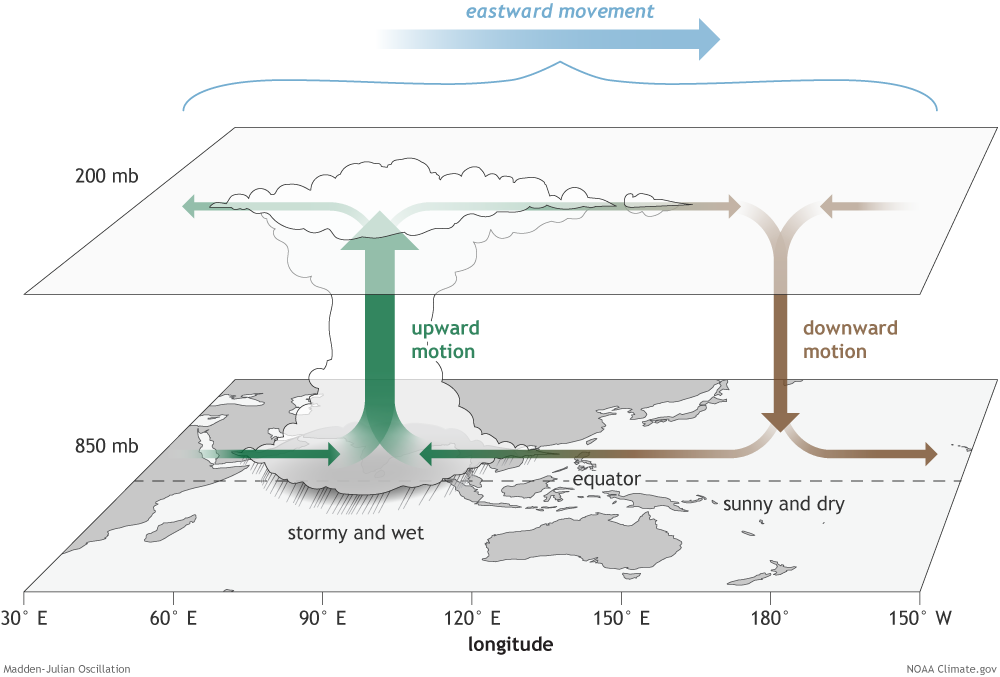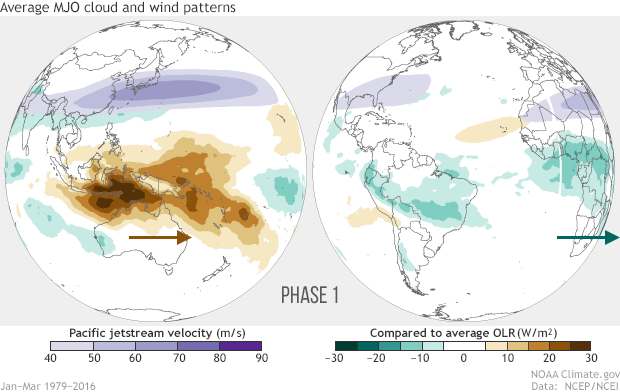Researchers Rise to Challenge of Predicting Severe Weather Weeks in Advance
Special Stories
3 Dec 2018 8:50 AM
[Tornado captured in North Dakota by Sarah Duttenhefner from July]
[CSU by Anne Manning] People living in Kansas, Nebraska and other states in the Plains are no strangers to tornadoes and hail storms – among the most costly and dangerous weather threats in the United States.
Meteorologists and computer models do a good job forecasting thunderstorm activity up to a week in advance. Scientists can also read long-term, seasonal signals of severe weather months in advance. But there’s a middle ground – a prediction lead time of about 2 to 5 weeks – that’s sorely lacking in current forecasting capabilities.
In a new paper in Journal of Geophysical Research: Atmospheres, Colorado State University atmospheric scientists demonstrate the ability to make skillful predictions of severe weather across the Plains and southeastern United States, including hail and tornadoes, in that coveted 2-to-5-weeks-in-advance period. To do it, they use a reliable tropical weather pattern called the Madden-Julian Oscillation, which can influence weather in distant parts of the Earth, including the U.S., by sending out powerful atmospheric waves.
 [The surface and upper-atmosphere structure of the MJO for a period when the enhanced convective phase (thunderstorm cloud) is centered across the Indian Ocean and the suppressed convective phase is centered over the west-central Pacific Ocean. Horizontal arrows pointing left represent wind departures from average that are easterly, and arrows pointing right represent wind departures from average that are westerly. The entire system shifts eastward over time, eventually circling the globe and returning to its point of origin. NOAA Climate drawing by Fiona Martin]
“When the Madden-Julian Oscillation is active, it is capable of setting up atmospheric patterns that are favorable for severe weather across the United States over the next several weeks,” explained Cory Baggett, research scientist in atmospheric science and the paper’s lead author. “We have found that an active Madden-Julian Oscillation, which periodically goes around the equator in 30 to 60 days, is a really good source of predictability on these subseasonal time scales.” Atmospheric scientists typically consider “subseasonal” to mean about three weeks to three months in advance.
[The surface and upper-atmosphere structure of the MJO for a period when the enhanced convective phase (thunderstorm cloud) is centered across the Indian Ocean and the suppressed convective phase is centered over the west-central Pacific Ocean. Horizontal arrows pointing left represent wind departures from average that are easterly, and arrows pointing right represent wind departures from average that are westerly. The entire system shifts eastward over time, eventually circling the globe and returning to its point of origin. NOAA Climate drawing by Fiona Martin]
“When the Madden-Julian Oscillation is active, it is capable of setting up atmospheric patterns that are favorable for severe weather across the United States over the next several weeks,” explained Cory Baggett, research scientist in atmospheric science and the paper’s lead author. “We have found that an active Madden-Julian Oscillation, which periodically goes around the equator in 30 to 60 days, is a really good source of predictability on these subseasonal time scales.” Atmospheric scientists typically consider “subseasonal” to mean about three weeks to three months in advance.
 [Averages of all January–March MJO events from 1979–2016. Green shading shows below-average OLR (outgoing longwave radiation, or heat energy) values, indicating more clouds and rainfall, and brown shading identifies above-average OLR (drier and clearer skies than normal). The purple contours show the location and strength of the Pacific jet at the 200-hPa level (roughly 38,000 feet at that location). Note the eastward movement of the wet and dry areas. How far the Pacific jet extends past the international dateline also changes with the phase of the MJO. NOAA Climate animation adapted from original images provided by Carl Schreck.]
“We’re judging ourselves against climatology,” Childs said. “If we predicted normal thunderstorm activity, we would be right about 50 percent of the time. Three weeks out, we’re getting it right about 2-1.” They also found consistently stronger ability to forecast hail and tornado activity during certain phases of the Madden-Julian Oscillation.
[Averages of all January–March MJO events from 1979–2016. Green shading shows below-average OLR (outgoing longwave radiation, or heat energy) values, indicating more clouds and rainfall, and brown shading identifies above-average OLR (drier and clearer skies than normal). The purple contours show the location and strength of the Pacific jet at the 200-hPa level (roughly 38,000 feet at that location). Note the eastward movement of the wet and dry areas. How far the Pacific jet extends past the international dateline also changes with the phase of the MJO. NOAA Climate animation adapted from original images provided by Carl Schreck.]
“We’re judging ourselves against climatology,” Childs said. “If we predicted normal thunderstorm activity, we would be right about 50 percent of the time. Three weeks out, we’re getting it right about 2-1.” They also found consistently stronger ability to forecast hail and tornado activity during certain phases of the Madden-Julian Oscillation.
 [The surface and upper-atmosphere structure of the MJO for a period when the enhanced convective phase (thunderstorm cloud) is centered across the Indian Ocean and the suppressed convective phase is centered over the west-central Pacific Ocean. Horizontal arrows pointing left represent wind departures from average that are easterly, and arrows pointing right represent wind departures from average that are westerly. The entire system shifts eastward over time, eventually circling the globe and returning to its point of origin. NOAA Climate drawing by Fiona Martin]
“When the Madden-Julian Oscillation is active, it is capable of setting up atmospheric patterns that are favorable for severe weather across the United States over the next several weeks,” explained Cory Baggett, research scientist in atmospheric science and the paper’s lead author. “We have found that an active Madden-Julian Oscillation, which periodically goes around the equator in 30 to 60 days, is a really good source of predictability on these subseasonal time scales.” Atmospheric scientists typically consider “subseasonal” to mean about three weeks to three months in advance.
[The surface and upper-atmosphere structure of the MJO for a period when the enhanced convective phase (thunderstorm cloud) is centered across the Indian Ocean and the suppressed convective phase is centered over the west-central Pacific Ocean. Horizontal arrows pointing left represent wind departures from average that are easterly, and arrows pointing right represent wind departures from average that are westerly. The entire system shifts eastward over time, eventually circling the globe and returning to its point of origin. NOAA Climate drawing by Fiona Martin]
“When the Madden-Julian Oscillation is active, it is capable of setting up atmospheric patterns that are favorable for severe weather across the United States over the next several weeks,” explained Cory Baggett, research scientist in atmospheric science and the paper’s lead author. “We have found that an active Madden-Julian Oscillation, which periodically goes around the equator in 30 to 60 days, is a really good source of predictability on these subseasonal time scales.” Atmospheric scientists typically consider “subseasonal” to mean about three weeks to three months in advance.
Favorable conditions
Weather forecasting weeks in advance cannot pinpoint where individual tornadoes or hail storms will occur, Baggett explained, but the researchers have shown they can forecast expected environmental conditions that are favorable for the formation of severe thunderstorms. That includes atmospheric instability and rotational vertical wind shear. Using available datasets, researchers looked at what the Madden-Julian Oscillation was doing about three weeks ahead of severe weather in the Plains and southeastern United States, during the typical severe-weather months of March through June. They used 37 years of data to cross-validate their predictions. They found “forecasts of opportunity” where they were able to make skillful predictions of severe weather activity about 60 percent to 70 percent of the time. Meteorologists would consider this rate of success “great,” according to Sam Childs, a Ph.D. student in atmospheric science who co-authored the work. [Averages of all January–March MJO events from 1979–2016. Green shading shows below-average OLR (outgoing longwave radiation, or heat energy) values, indicating more clouds and rainfall, and brown shading identifies above-average OLR (drier and clearer skies than normal). The purple contours show the location and strength of the Pacific jet at the 200-hPa level (roughly 38,000 feet at that location). Note the eastward movement of the wet and dry areas. How far the Pacific jet extends past the international dateline also changes with the phase of the MJO. NOAA Climate animation adapted from original images provided by Carl Schreck.]
“We’re judging ourselves against climatology,” Childs said. “If we predicted normal thunderstorm activity, we would be right about 50 percent of the time. Three weeks out, we’re getting it right about 2-1.” They also found consistently stronger ability to forecast hail and tornado activity during certain phases of the Madden-Julian Oscillation.
[Averages of all January–March MJO events from 1979–2016. Green shading shows below-average OLR (outgoing longwave radiation, or heat energy) values, indicating more clouds and rainfall, and brown shading identifies above-average OLR (drier and clearer skies than normal). The purple contours show the location and strength of the Pacific jet at the 200-hPa level (roughly 38,000 feet at that location). Note the eastward movement of the wet and dry areas. How far the Pacific jet extends past the international dateline also changes with the phase of the MJO. NOAA Climate animation adapted from original images provided by Carl Schreck.]
“We’re judging ourselves against climatology,” Childs said. “If we predicted normal thunderstorm activity, we would be right about 50 percent of the time. Three weeks out, we’re getting it right about 2-1.” They also found consistently stronger ability to forecast hail and tornado activity during certain phases of the Madden-Julian Oscillation.
Future products
To understand whether this new method of predicting severe weather would be useful to forecasters, the researchers hope they can transition the work to operational experts who could test it out. “In essence, these forecasts of opportunity would allow a forecaster to better alert the public of a period in which severe weather may be more likely a few weeks in advance,” Childs said. “I think we were all surprised at how good some of our forecasts were,” he added. “That’s motivation enough to carry forward, so that we might be able to have more useful forecasting products in that coveted 2-to-5-week lead time.” Edited for WeatherNation by Meteorologist Mace MichaelsAll Weather News
More